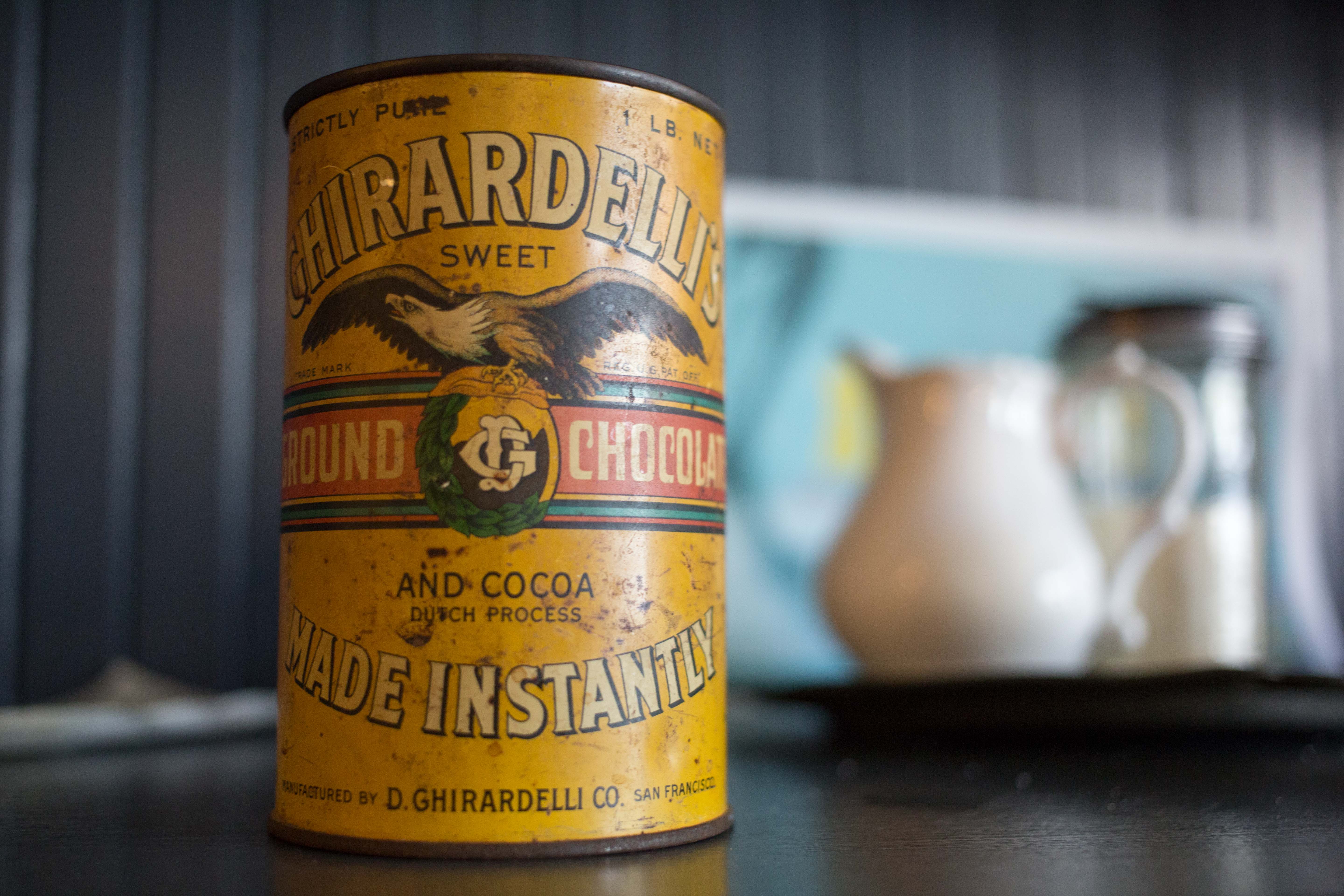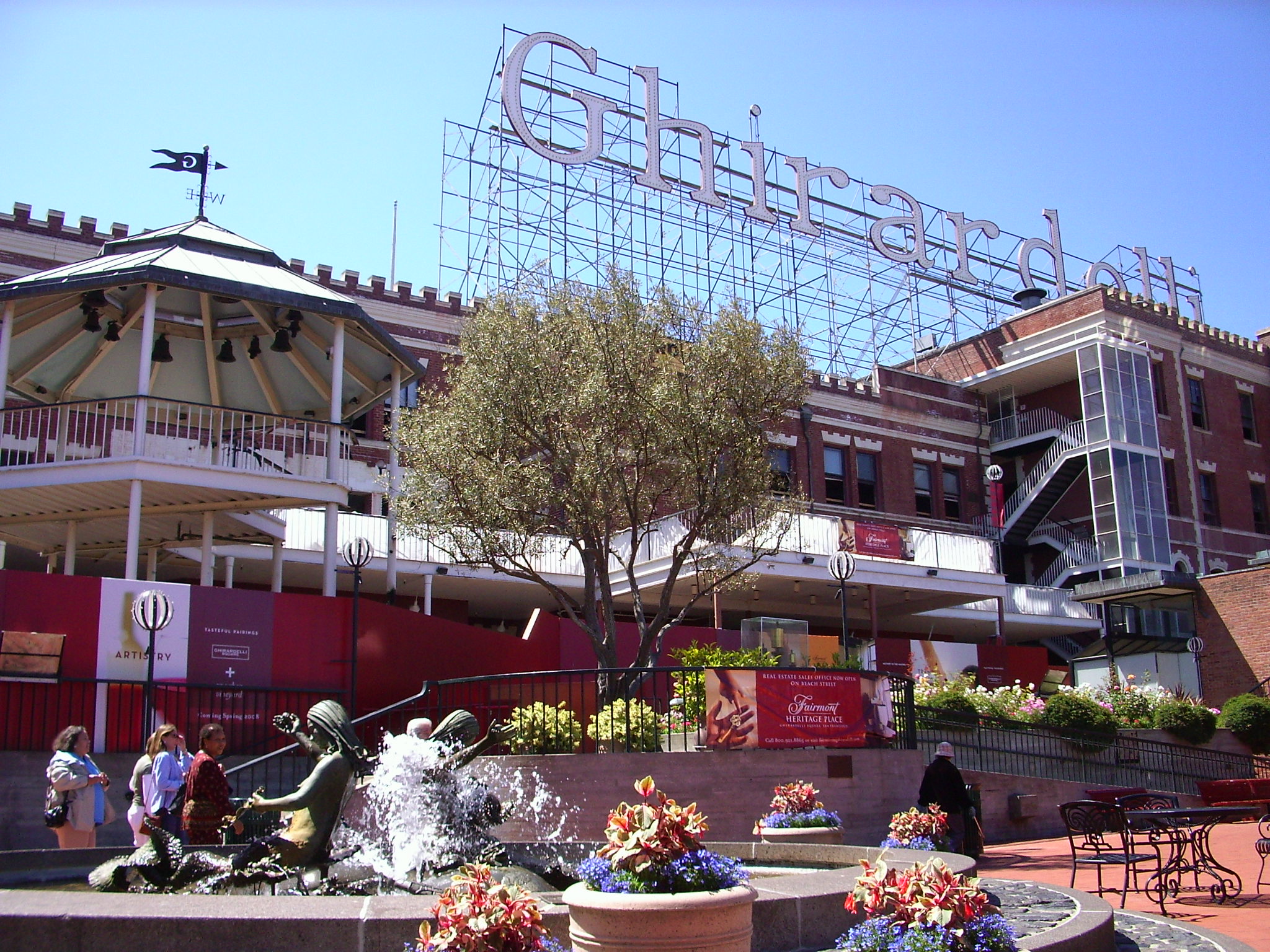|
Ghirardelli
The Ghirardelli Chocolate Company (simply known as Ghirardelli) is an American confectioner, wholly owned by multinational confectioner Lindt & Sprüngli. The company was founded by and is named after Italian chocolatier Domenico Ghirardelli, who, after working in South America, moved to California. The Ghirardelli Chocolate Company was incorporated in 1852, and is the third-oldest chocolate company in the US, after Baker's Chocolate and Whitman's. History Origins In 1817, Domenico Ghirardelli was born in Rapallo, Italy, to an "exotic foods importer" and his wife. Domenico received his first education in the chocolate trade when he was apprenticed to a local candymaker as a child. By the time he was 20, Ghirardelli had sailed to Uruguay with his wife to work in a chocolate and coffee business. A year later, Ghirardelli moved to Lima, Peru, and opened a confectionery store. In 1847, nine years later, James Lick (Ghirardelli's neighbor) moved to San Francisco, California, ... [...More Info...] [...Related Items...] OR: [Wikipedia] [Google] [Baidu] |
Domingo Ghirardelli
Domenico "Domingo" Ghirardelli (; February 21, 1817 – January 17, 1894) was an Italian-born chocolatier who was the founder of the Ghirardelli Chocolate Company in San Francisco, California. Biography Early life Domenico Ghirardelli was born on February 21, 1817, in Rapallo, Italy, to Giuseppe and Maddalena ( Ferretto) Ghirardelli. His father was a spice merchant in Genoa. In his teens, he apprenticed at Romanengo, a noted chocolatier in Genoa. At about the age of twenty, in 1838, he moved to Uruguay, then in 1838 to Lima, Lima, Peru, where he established a confectionery, and began using the Spanish language, Spanish equivalent of his Italian language, Italian name, Domingo. In 1849 he moved to California on the recommendation of his former neighbor, James Lick, who had brought 600 pounds of chocolate with him to San Francisco, California, San Francisco in 1848. Caught up in the California Gold Rush, he opened his first store in a mining camp to sell sweets and treats to min ... [...More Info...] [...Related Items...] OR: [Wikipedia] [Google] [Baidu] |
Ghirardelli Square
Ghirardelli Square is a landmark public square at the foot of Russian Hill and adjacent to the Aquatic Park Historic District in San Francisco. It is often considered to be part of the tourist attractions at nearby Fisherman's Wharf. A portion of the area was listed on the National Register of Historic Places in 1982 as Pioneer Woolen Mills and D. Ghirardelli Company. The square once featured over 40 specialty shops and restaurants. Some of the original shops and restaurants still occupy the square. History In 1893, Domenico Ghirardelli purchased the entire city block in order to make it into the headquarters of the Ghirardelli Chocolate Company. In the early 1960s, the Ghirardelli Chocolate Company was bought by the Golden Grain Macaroni Company, which moved the headquarters off-site to San Leandro and put the square up for sale. San Franciscan William M. Roth and his mother, Lurline Matson Roth, bought the land in 1962 to prevent the square from being replaced with ... [...More Info...] [...Related Items...] OR: [Wikipedia] [Google] [Baidu] |
Lindt & Sprüngli
Chocoladefabriken Lindt & Sprüngli AG, doing business as Lindt, is a Swiss chocolatier and confectionery company founded in 1845 and known for its chocolate truffles and chocolate bars, among other sweets. It is based in Kilchberg, Zürich, Kilchberg, where its main factory and museum are located. Lindt is one of the largest Swiss chocolate manufacturers. History Founding and early years The origins of the company date back to 1836, when David Sprüngli (1776–1862) and his son Rudolf Sprüngli-Ammann (1816–1897) bought a small confectionery shop in the old town of Zürich, producing chocolates under the name David Sprüngli & Son. Before they moved to Paradeplatz in 1845, they established a small factory where they produced their chocolate in solidified form in 1838. When Rudolf Sprüngli-Ammann retired in 1892, he gave two equal parts of the business to his sons. The younger brother David Robert received two confectionery stores that became known under the name Confiser ... [...More Info...] [...Related Items...] OR: [Wikipedia] [Google] [Baidu] |
James Lick
James Lick (August 25, 1796 – October 1, 1876) was an American real estate investor, carpenter, piano builder, land baron, and patron of the sciences. The wealthiest man in California at the time of his death, Lick left the majority of his estate to social and scientific causes. Early years James Lick was born to Pennsylvania Dutch parents in Stumpstown ( Fredericksburg), Pennsylvania on August 25, 1796. Lick's paternal grandfather, William was a German immigrant from the Palatinate, and served in the American Revolutionary War. William's son, John, anglicized the family name to Lick. The son of a carpenter, Lick began learning the craft at an early age. When he was twenty-one, he had a romance with Barbara Snavely, the mother of his only child, John Henry. They never married, and the romance failed. Lick left Stumpstown for Baltimore, Maryland, where he learned the art of piano making. He quickly mastered the skill, and moved to New York City and established his own shop ... [...More Info...] [...Related Items...] OR: [Wikipedia] [Google] [Baidu] |
Chocolate
Chocolate is a food made from roasted and ground cocoa beans that can be a liquid, solid, or paste, either by itself or to flavoring, flavor other foods. Cocoa beans are the processed seeds of the cacao tree (''Theobroma cacao''); unprocessed, they taste intensely bitter. In making chocolate, these seeds Cocoa bean fermentation, are usually fermented to develop the flavor. They are then dried, cleaned, and roasted. The shell is removed to reveal nibs, which are ground to chocolate liquor: unadulterated chocolate in rough form. The liquor can be processed to separate its two components, cocoa solids and cocoa butter, or shaped and sold as unsweetened baking chocolate. By adding sugar, sweetened chocolates are produced, which can be sold simply as dark chocolate (a.k.a., plain chocolate), or, with the addition of milk, can be made into milk chocolate. Making milk chocolate with cocoa butter and without cocoa solids produces white chocolate. In some chocolates, other ingredients ... [...More Info...] [...Related Items...] OR: [Wikipedia] [Google] [Baidu] |
San Leandro, California
San Leandro (Spanish language, Spanish for "Leander of Seville, St. Leander") is a city in Alameda County, California, United States. It is located in the East Bay of the San Francisco Bay Area; between Oakland, California, Oakland to the northwest, and Ashland, California, Ashland, Castro Valley, California, Castro Valley, and Hayward, California, Hayward to the southeast. The population was 91,008 as of the 2020 census. History Spanish and Mexican eras The Spanish settlers called these natives ''Costeños'', or 'coast people,' and the English-speaking settlers called them Ohlone, Costanoans. San Leandro was first visited by Europeans on March 20, 1772, by Spanish soldier Captain Pedro Fages and the Spanish Catholic priest Father Crespi. San Leandro is located on the Rancho San Leandro and Rancho San Antonio (Peralta), Rancho San Antonio Ranchos of California, Mexican land grants. Its name refers to Leander of Seville, a sixth-century Spanish bishop. Both land grants were l ... [...More Info...] [...Related Items...] OR: [Wikipedia] [Google] [Baidu] |
San Francisco Fire Of 1851
The San Francisco Fire of 1851 (May 3–4, 1851) was a catastrophic conflagration that destroyed as much as three-quarters of San Francisco, California. History During the height of the California gold rush, between December 1849 and June 1851, San Francisco endured a sequence of seven severe fires, of which this was the sixth and by far the most damaging. In terms of property value, it did three times as much damage as the next most destructive of the seven fires. Around 11 pm on the night of May 3, 1851, a fire (possibly arson) broke out in a paint and upholstery store above a hotel on the south side of Portsmouth Square in San Francisco. Fueled by increasingly high winds, the fire was initially carried down Kearny St. and then, as the winds shifted to the south, into the downtown area, where the elevated wood-plank sidewalks provided extra fuel. The fire, which was visible for miles out to sea, continued for about 10 hours and eventually extended to at least 18 blocks of th ... [...More Info...] [...Related Items...] OR: [Wikipedia] [Google] [Baidu] |





